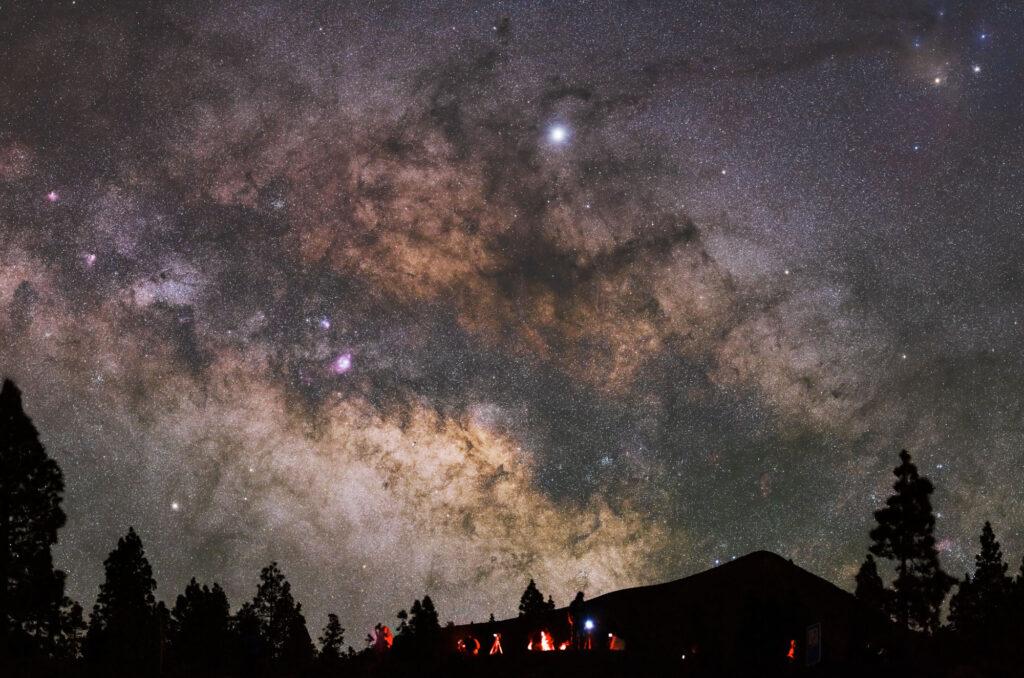Look up. How many stars do you see after nightfall? If you live in a major city like Washington, D.C., chances are you’ll see nothing more than the hazy glow of street lights blanketing the sky.
This is due to light pollution, the brightening of the night sky caused by street lights and other man-made light sources. Light pollution has a wide range of negative effects, including wasted energy, ecosystem disruptions, and a loss of culture and human identity.
On March 23, the Smithsonian National Museum of Natural History (NMNH) opened an exhibit titled “Lights Out: Recovering Our Night Sky” that showcases the wide impacts of light pollution in an immersive multimedia experience that includes over 100 photographs, nearly 250 objects and a theater program.

More than 80% of people worldwide live under light-polluted skies, with 80% of North America being unable to see the Milky Way Galaxy in the night sky, according to press materials about the exhibit. Moreover, about 30% of all outdoor lighting in the United States is wasted on “illuminated shrubs” and other unnecessary uses, amounting to an excess electricity bill of nearly $3.5 billion.
Stephen Loring, a curator of the exhibit who is also an anthropologist and an archeologist of Arctic studies at the NMNH, said the exhibit was created in response to growing recognition of the problem of light pollution and a feeling of responsibility to inform the public about their ability to mitigate its impacts.
“As a natural history museum, I think we have a profound responsibility to address concerns that affect the well-being of the planet,” Loring said in an interview with The Hoya.
Exhibit co-curator Kim Arcand, a visualization scientist at the Harvard-Smithsonian Center for Astrophysics, says the effects of light pollution are all around us.
“Light pollution touches so many areas of our life, our existence. It affects all kinds of different life, it affects natural ecosystems, it can affect human cultures, human behaviors. There’s a lot of bandwidth to the reach this topic has,” Arcand told The Hoya.
At the exhibit, visitors can walk through a sequence of eight sections, ranging from a history of lighting and light pollution to a section on the impacts on animal populations to a section on art that has been inspired by the night sky.
In a section of the exhibit titled “Who Needs the Dark?” visitors can see specimens of plants and animals that have been affected by light pollution. These include birds becoming disoriented by artificial light during migration season, fireflies whose mating success depends on light signals between males and females, and humans whose circadian rhythms are disrupted by excess night-time light.
Visitors can also marvel at a section titled “Connecting with the Night Sky,” which displays a collection of human artifacts and art depicting the night sky. This includes a Gwich’in beaded tapestry of the night sky by Margaret Nazon and a digital image of Vincent van Gogh’s famous “Starry Night” painting.
In curating the exhibit, Arcand and Loring wanted to emphasize how important the night sky is for inspiring human creativity throughout history.
“If Van Gogh had not had access to the night sky when he was dreaming up the painting, it would not look anything like it does, and perhaps wouldn’t have even gotten painted,” Arcand told The Hoya.
According to the exhibit, the loss of dark skies in cities has also been a challenge for astronomers.
Owen Chbani (SFS ’25), vice president of the Georgetown University Astronomical Society, says light pollution makes stargazing in the District a challenge.
“Light pollution turns up the background brightness of the sky,” Chbani told The Hoya. “Where you’d normally be able to see a galaxy, it’s drowned out by the brightness of the sky. It literally turns out what you’d see.”
Light pollution is why the university’s astronomical observatory closed down in 1972, according to Chbani. When on campus, stargazers have to deal with both the sky glow from the city and the lights around them.
According to Loring, stargazing can ground us and give us perspective that we cannot risk losing.
“This is our home, this is our planet and I think being connected to our night sky is such a powerful way of realizing how small we are in the world and how desperate it is that we protect it and preserve it,” Loring told The Hoya.
Fortunately, light pollution can be mitigated if people take steps to ensure the lights they use are useful, targeted, low, controlled and warm, as outlined in the section titled “Reclaiming the Night Sky,” which was developed in collaboration with the International Dark-Sky Association.
“This is something that’s eminently fixable,” Arcand told The Hoya. “This is one of the few areas around our climate, around how we treat our planet that is pretty much fixable just by switching off the light. I love that this feels like we might have some agency.”
Loring says he hopes the exhibit, which will be on display in the museum until December 2025, inspires people to reconsider their role and personal contribution to light pollution.
“I hope it encourages wonder, and I hope it encourages people to think about what we’re losing,” Loring told The Hoya. “We need some kind of consciousness or awakening that turns people around. I’m not saying our exhibit does it, but it’s a nod in the right direction.”








